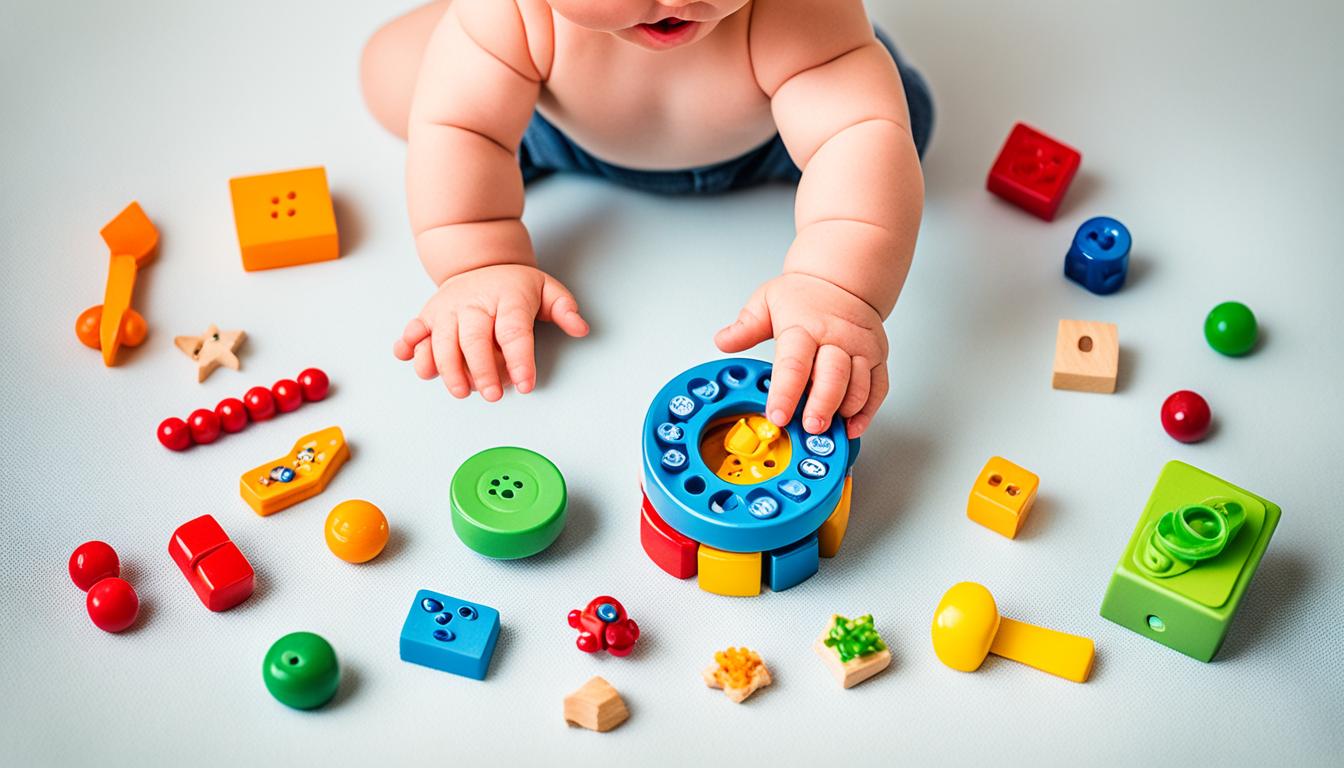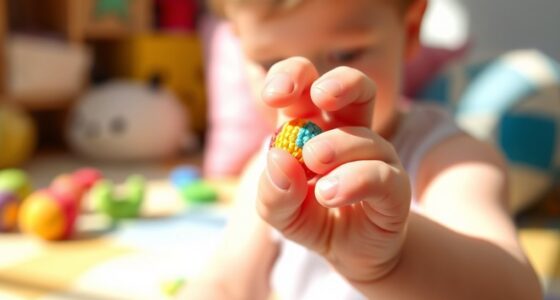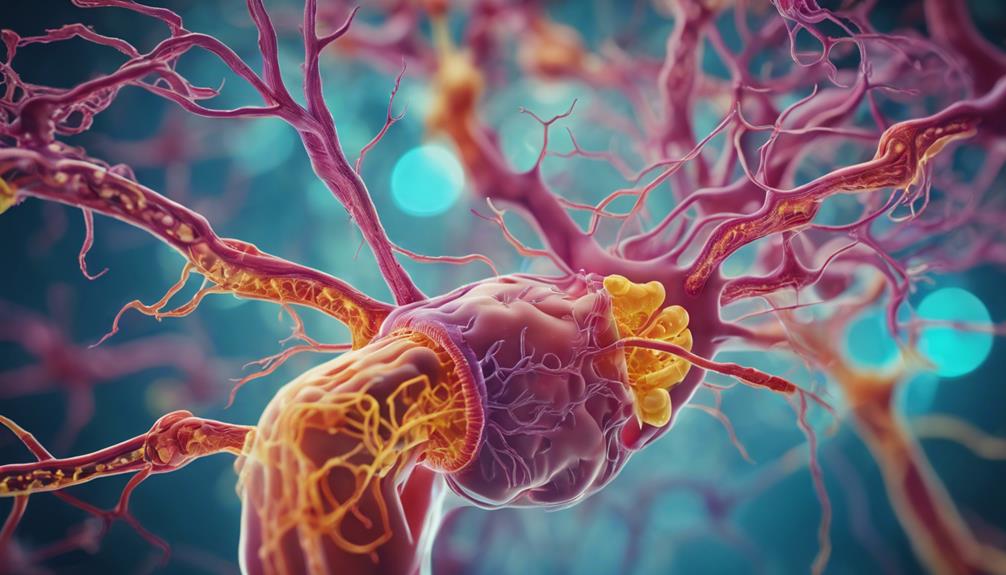To ensure your baby stays active, participate in exercises such as Happy Baby pose for flexibility and Downward Facing Dog for strength. Tummy time is essential for strengthening the neck and upper body. These activities help improve coordination, balance, and motor skills. Encourage crawling by supporting hand-eye coordination and gross motor skill development. Interactive activities aid in refining hand-eye coordination, cognitive skills, and motor skills. Building muscle strength contributes to overall physical well-being. An active baby not only develops physically but also boosts cognitive abilities. Discover more about the advantages of baby exercises and fundamental stretching routines to assist your baby’s growth and development.
Key Takeaways
- Engage in baby-friendly exercises to enhance muscle development and coordination skills.
- Include activities like tummy time and face time to strengthen neck, head, and upper body muscles.
- Encourage crawling skills to boost cognitive development, coordination, and physical activity levels.
- Promote hand-eye coordination through interactive activities and object exploration.
- Support overall physical well-being by incorporating essential stretch exercises and strengthening routines.
Benefits of Baby Exercise
Engaging in baby exercise offers numerous benefits for your little one's development and well-being. Baby exercise plays an essential role in enhancing muscle development, coordination skills, and cognitive development. Through activities like tummy time, gentle massage, leg cycling, and baby yoga poses, your baby's muscles are stimulated, leading to improved strength and motor skills. These exercises also help in developing coordination skills, as your little one learns to control their movements and explore their surroundings.
Moreover, engaging in baby exercise strengthens the bond between you and your child. The quality time spent together during these activities fosters a strong parent-child relationship. Additionally, incorporating baby exercise into your routine can aid in establishing better sleep patterns for your little one. The physical activity and stimulation received during these exercises can contribute to a more restful night's sleep for your baby.
Essential Baby Stretch Exercises
Looking to enhance your baby's flexibility and muscle strength? Baby stretch exercises are a fantastic way to achieve just that.
The Happy Baby pose is a popular choice, helping your little one stretch their legs and lower back, promoting flexibility.
Downward Facing Dog is another beneficial stretch that not only aids in improving muscle strength but also enhances circulation in your baby's body.
The Butterfly Twist is great for working on hip flexibility, which is essential for overall mobility.
Additionally, baby neck strengthening exercises play an important role in developing the neck muscles necessary for better head control.
By incorporating these stretches into your baby's routine, you can help them build a strong foundation of flexibility, muscle strength, and overall physical well-being.
Strengthening Baby's Neck and Tummy
To enhance your baby's neck and tummy muscles, prioritize incorporating tummy time into their daily routine. Tummy time is essential as it helps build neck, head, and upper body strength, promoting overall physical development.
Engaging in face time during tummy time not only strengthens neck muscles but also encourages reaching and grasping skills, enhancing coordination. Starting tummy time soon after birth is vital to developing essential muscles, and gradually increasing tummy time duration further supports your baby's growth.
During tummy time, encourage your baby to play and explore their surroundings. This not only aids in building neck strength but also fosters coordination and motor skills. By providing opportunities for your baby to reach and interact with objects during tummy time, you're helping them develop crucial muscle groups and improve their overall physical abilities.
Promoting Baby Crawling Skills

Encouraging your baby to crawl is an essential step in fostering their motor skills and overall physical development. Crawling plays an important role in developing your baby's motor skills, including coordination, balance, and strength. It also helps in improving muscle tone and enhancing their physical activity levels.
Here's how promoting crawling can benefit your baby:
- Enhanced Hand-Eye Coordination: Crawling helps in the development of hand-eye coordination, which is essential for your baby's future motor skills and activities.
- Improved Gross Motor Skills: By encouraging your baby to crawl, you're aiding in the development of their gross motor skills, such as coordination and balance.
- Cognitive Development: Babies who crawl tend to have better cognitive development and problem-solving skills, making crawling an important milestone in their growth and learning journey.
Improving Baby's Hand-Eye Coordination

Improving your baby's hand-eye coordination involves engaging in activities that encourage them to explore and interact with objects using their hands and mouth. As early as 3 to 4 months, babies can start honing their coordination skills through engaging activities like 'Catch the Toy' and 'Bubble Gaze'.
These activities not only enhance hand-eye coordination but also play a crucial role in cognitive development and motor skill development.
By grasping objects and bringing them to their mouths, babies are actively improving their ability to coordinate their hand movements with what they see. Activities that involve tracking and reaching for objects help strengthen the connection between what their eyes see and how their hands respond.
Encouraging these interactions from a young age sets a foundation for better hand-eye coordination as your baby grows. Remember, these activities aren't just playtime; they're essential for your baby's overall development.
Frequently Asked Questions
Does Exercise Make Baby More Active?
Yes, exercise makes your baby more active. By engaging in physical activities like tummy time and movement-based play, you can help boost muscle strength, coordination, and motor skills development, fostering a healthy and active lifestyle.
How Do I Keep My Baby Busy While Working Out?
Trying to juggle lunges and baby entertainment? Stick a rattle in one hand and a dumbbell in the other. Engage your little one with toys, carriers, and yoga poses. Sing, chat, and create a play zone for your mini multitasker!
How Do You Stay Active With a Baby?
To stay active with a baby, incorporate them into your routine. Take walks together, dance, and engage in interactive play. Use carriers to keep them close. You'll bond, boost your fitness, and create fun memories.
How Do I Keep My Active Baby Busy?
To keep your active baby busy, engage in tummy time, encourage crawling, rolling, and standing with support, offer toys for grasping and pushing, incorporate music for sensory stimulation, and limit time in restrictive equipment.
Conclusion
To sum up, participating in baby exercise is essential for promoting your little one's physical development and overall health. Just like a seed needs sunlight to grow into a strong tree, your baby needs movement to strengthen their muscles and coordination.
By incorporating simple stretches and activities into your daily routine, you can help your baby reach important milestones and set a foundation for a healthy and active lifestyle.
So don't forget to keep your baby moving and grooving!










